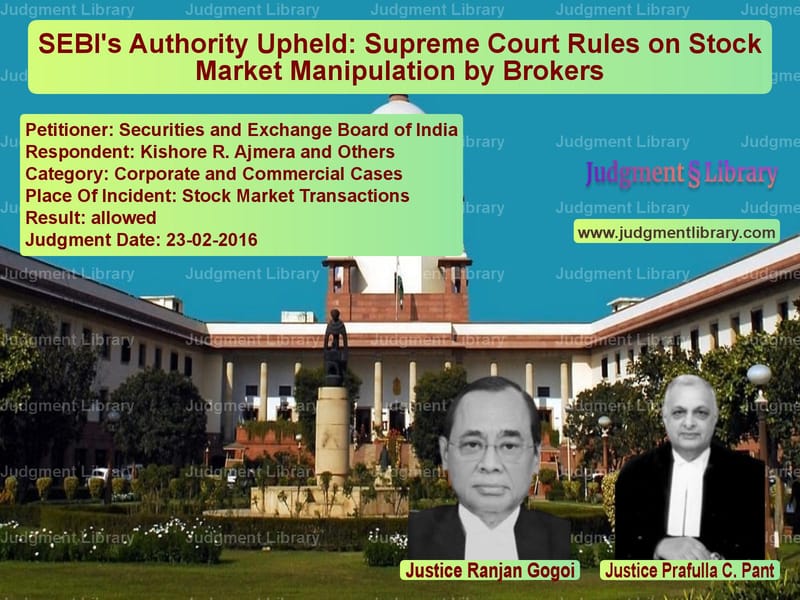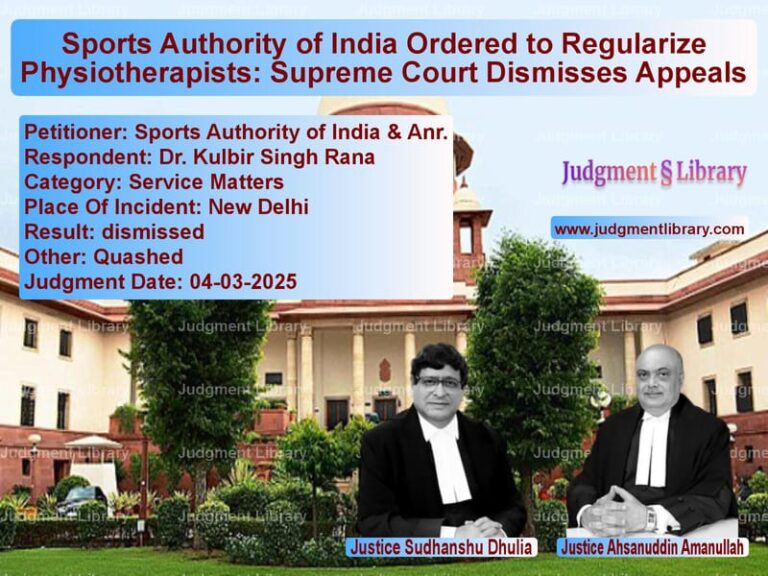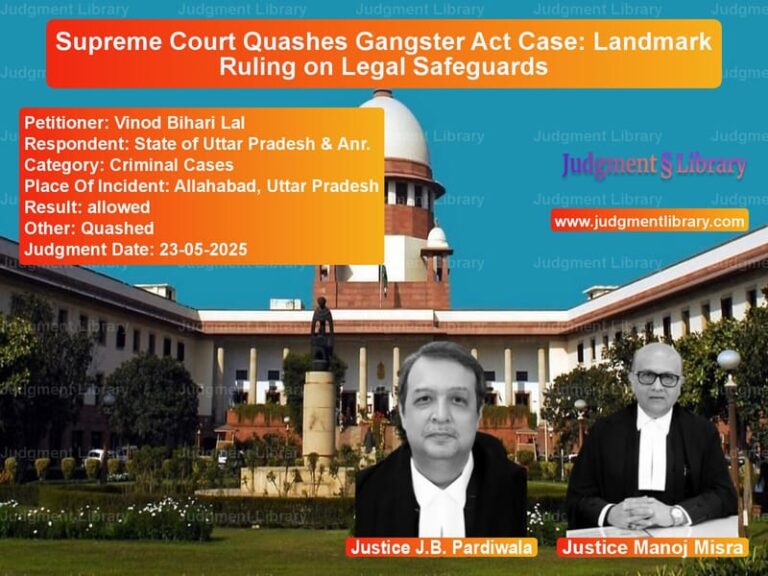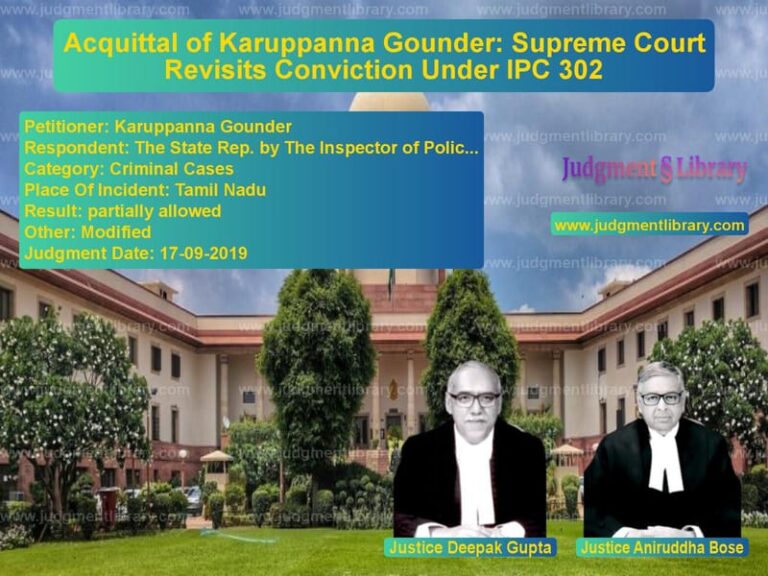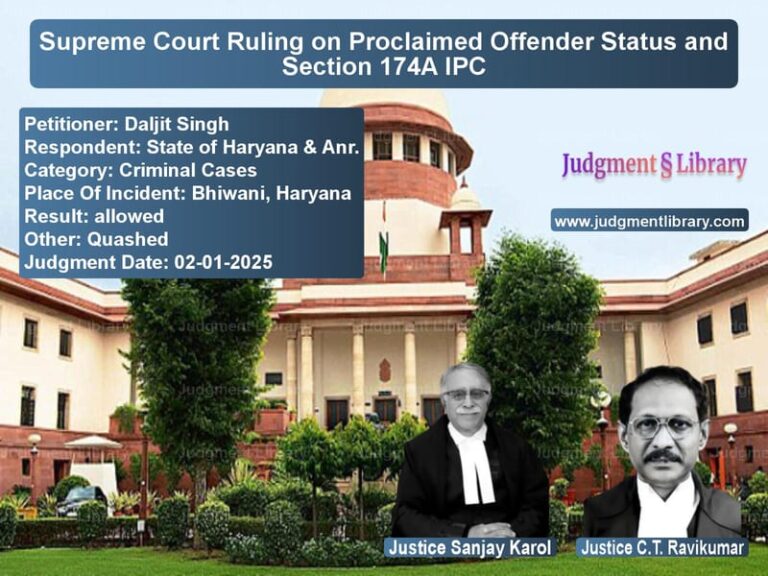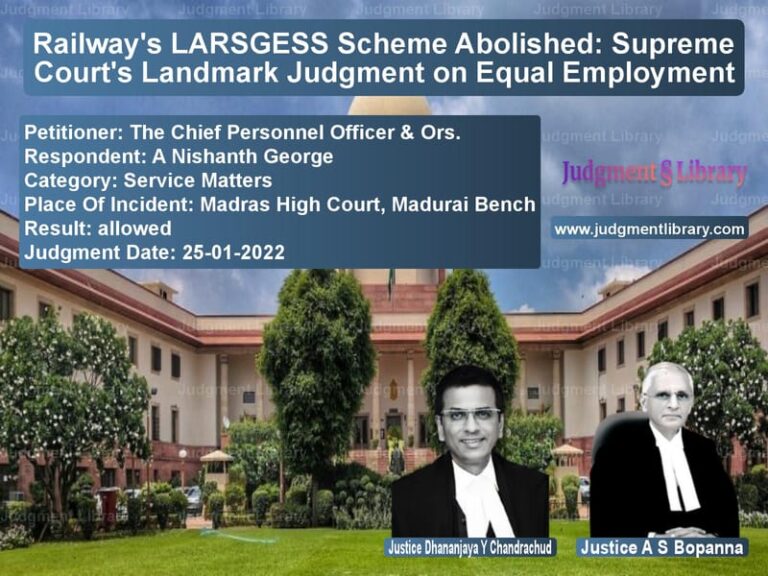SEBI’s Authority Upheld: Supreme Court Rules on Stock Market Manipulation by Brokers
The Supreme Court of India has delivered a crucial judgment in the case of Securities and Exchange Board of India (SEBI) vs. Kishore R. Ajmera & Others, addressing the issue of fraudulent and manipulative trading practices in the stock market. The judgment sets an important precedent regarding the liability of brokers and sub-brokers under the Securities and Exchange Board of India (Prohibition of Fraudulent and Unfair Trade Practices Relating to Securities Market) Regulations and the SEBI (Stock Brokers and Sub-Brokers) Regulations, 1992.
The ruling clarifies the degree of proof required to establish liability and holds brokers accountable for their role in fraudulent activities, including synchronized and circular trading. The case involves multiple brokers accused of artificially inflating stock prices through unfair trade practices.
Background of the Case
The case primarily revolves around stock brokers and sub-brokers who were allegedly involved in synchronized trading, circular trading, and artificial volume creation in illiquid stocks. SEBI launched investigations into several brokers accused of violating securities market regulations.
The appeals before the Supreme Court included cases where the Securities Appellate Tribunal (SAT) had overturned penalties imposed by SEBI. The Court was tasked with determining whether the brokers were liable under the FUTP Regulations and the Conduct Regulations for stockbrokers.
Key Legal Issues
The Supreme Court framed the core legal question:
- What is the required degree of proof to hold brokers and sub-brokers liable for fraudulent and manipulative practices in the stock market?
- Can brokers be held responsible for the actions of their sub-brokers and clients if direct evidence of collusion is absent?
- Does circumstantial evidence suffice to establish liability in cases of synchronized trading?
Petitioner’s (SEBI’s) Arguments
SEBI presented the following arguments to establish the brokers’ liability:
- Fraudulent Practices: SEBI argued that the accused brokers facilitated synchronized and circular trading in illiquid stocks, leading to artificial price inflation and misleading market participants.
- Role of Brokers: Brokers were responsible for ensuring market integrity and were expected to exercise due diligence. They failed to do so despite clear signs of manipulation.
- Circumstantial Evidence: SEBI maintained that in cases of market fraud, direct evidence is rare. The volume of trades, the speed of transactions, and the relationship between traders could establish a fraudulent scheme.
- Regulatory Compliance: Under Regulation 9 of SEBI (Stock Brokers and Sub-Brokers) Regulations, 1992, brokers must comply with the Code of Conduct. Their failure to act against manipulative trades constituted a regulatory breach.
Respondent’s (Brokers’) Arguments
The brokers challenged SEBI’s findings, arguing:
- Absence of Direct Evidence: There was no direct proof that the brokers were aware of their clients’ fraudulent activities.
- Screen-Based Trading: Transactions on stock exchanges are anonymous. Brokers do not know the identity of counterparties, making it impossible for them to conspire in market manipulation.
- Legitimacy of Trading Practices: The respondents contended that synchronized and circular trading were not inherently illegal unless there was specific intent to defraud.
- Due Process Violations: Some brokers alleged procedural lapses in SEBI’s investigation, including failure to provide full trade logs and client statements.
Supreme Court’s Ruling
The Supreme Court, in its judgment delivered by Justices Ranjan Gogoi and Prafulla C. Pant, upheld SEBI’s authority to penalize brokers for failing to prevent manipulative practices. The Court made the following key observations:
1. Circumstantial Evidence is Sufficient
The Court ruled that while direct evidence is preferable, circumstantial evidence can be used to establish fraudulent and manipulative trading practices. The judgment stated:
“It is a fundamental principle of law that proof of an allegation may be in the form of direct substantive evidence or inferred by logical reasoning from the totality of the attending facts and circumstances.”
2. Brokers’ Duty of Care
The judgment emphasized that brokers are not mere facilitators of trades but gatekeepers of market integrity. Their failure to act on suspicious trading patterns amounts to negligence and regulatory breach.
3. High-Volume Trading in Illiquid Stocks
The Court noted that synchronized trading in illiquid stocks over an extended period suggests manipulative intent. It ruled:
“While trading in illiquid scrips is not per se illegal, voluminous trading without genuine economic rationale raises serious concerns.”
4. Liability for Market Manipulation
The Court held that repeated patterns of trading within a short time gap (often under 60 seconds) between buy and sell orders indicated a concerted effort to manipulate stock prices. It ruled that such transactions fell under the definition of fraudulent and unfair trade practices under SEBI regulations.
Final Verdict
The Supreme Court’s judgment resulted in the following outcomes:
- SEBI’s appeals were allowed in cases involving brokers who engaged in high-volume synchronized trading.
- The Securities Appellate Tribunal’s (SAT) orders were overturned, reinstating penalties imposed by SEBI.
- Monetary penalties and suspensions imposed on brokers by SEBI were restored.
- One broker, Kishore R. Ajmera, was given relief due to insufficient evidence directly linking him to fraudulent trades.
Conclusion
The Supreme Court’s ruling strengthens SEBI’s enforcement power and underscores the responsibility of stockbrokers in preventing market manipulation. The judgment sets a significant precedent for future cases involving fraudulent trading and ensures greater transparency and integrity in India’s securities market.
This case highlights that regulators like SEBI have the authority to act against brokers who fail to prevent unfair trade practices, even when direct evidence of intent is unavailable. By upholding penalties for circumstantial evidence of market manipulation, the judgment serves as a strong deterrent against fraudulent activities in the financial sector.
Don’t miss out on the full details! Download the complete judgment in PDF format below and gain valuable insights instantly!
Download Judgment: Securities and Excha vs Kishore R. Ajmera an Supreme Court of India Judgment Dated 23-02-2016-1741852748205.pdf
Direct Downlaod Judgment: Direct downlaod this Judgment
See all petitions in Corporate Compliance
See all petitions in Shareholder Disputes
See all petitions in Company Law
See all petitions in Judgment by Ranjan Gogoi
See all petitions in Judgment by Prafulla C. Pant
See all petitions in allowed
See all petitions in supreme court of India judgments February 2016
See all petitions in 2016 judgments
See all posts in Corporate and Commercial Cases Category
See all allowed petitions in Corporate and Commercial Cases Category
See all Dismissed petitions in Corporate and Commercial Cases Category
See all partially allowed petitions in Corporate and Commercial Cases Category

